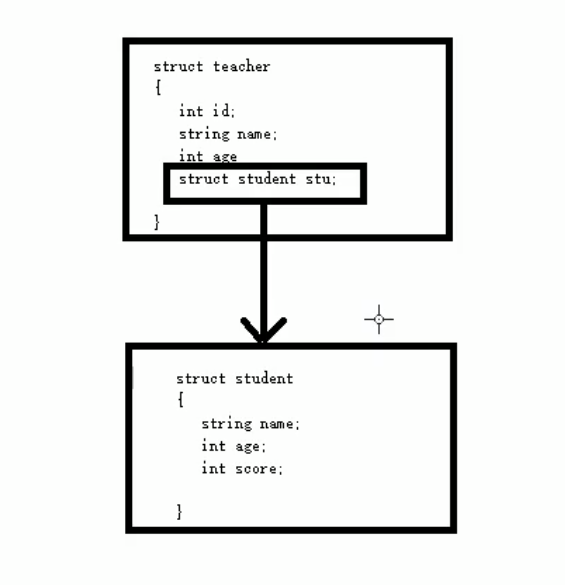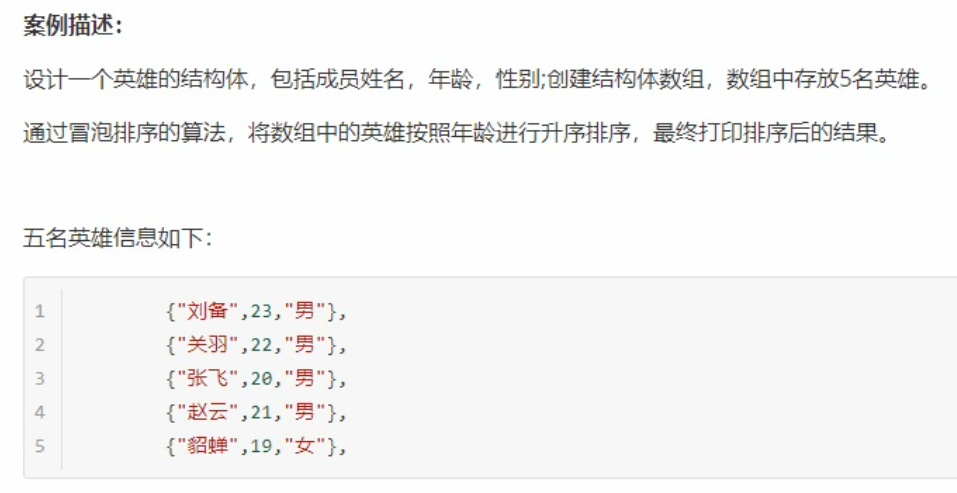C++学习 --- 结构体
结构体属于用户自定义数据类型,允许用户存储不同的数据类型。
语法: struct 结构体名 { 结构体成员列表 };
#include <iostream> #include <string> using namespace std; //1.创建学生数据类型 //学生:姓名、年龄、分数 struct Student{ string name; //姓名 int age; //年龄 float score; //分数 }s3; //2.通过学生的类型创建具体的学生 int main(){ //方法1,创建结构体 //struct Student s1; Student s1; //struct 关键字可以省略 s1.name = "Susan"; s1.age = 18; s1.score = 100; cout << "name: " << s1.name <<", age: " << s1.age << ", score:" << s1.score<< endl; //方法2,创建结构体 struct Student s2 = {"Lisoy",16,99.7}; cout << "name: " << s2.name <<", age: " << s2.age << ", score:" << s2.score<< endl; //方法3,创建结构体时顺便创建结构体变量 s3.name = "Wazoo"; s3.age = 15; s3.score = 98.6; cout << "name: " << s3.name <<", age: " << s3.age << ", score:" << s3.score<< endl; return 0; }
2、结构体数组
作用:将自定义结构体 放入到数组中,方便维护
语法: struct 结构体名 数组名[元素个数] { {结构体成员列表}, {}, ... {} };
#include <iostream> #include <string> using namespace std; //1.结构体定义 struct Student{ //成员列表 string name; //姓名 int age; //年龄 float score; //分数 }; int main(){ //2.创建结构体数组 struct Student stuArray[4] = { {"Susan",18,100}, {"Lisoy",16,99.7}, {"Wazoo",15,98.6}, }; //3.给结构体数组中的元素赋值 stuArray[3].name = "Ziser"; stuArray[3].age = 90; stuArray[3].score = 98.9; //4.遍历结构体数组 for(int i = 0;i < 4;i++){ cout << "name:" << stuArray[i].name << ", age:"<< stuArray[i].age <<", score:"<< stuArray[i].score << endl; } return 0; }
3、结构体指针
通过指针访问结构体中的成员
利用操作符 ->
#include <iostream> #include <string> using namespace std; //1.结构体定义 struct Student{ //成员列表 string name; //姓名 int age; //年龄 float score; //分数 }; int main(){ //2.创建学生的结构体变量 (struct 可省略) Student s = {"Susan",18,100}; //3.通过指向结构体变量 (struct 可省略) Student * p = &s; //4.通过指针访问结构体变量中的数据 cout << "name: " << p->name <<", age: " << p->age << ", score:" << p->score<< endl; return 0; }
4、结构体嵌套结构体
用于解决实际问题。

#include <iostream> #include <string> using namespace std; //1.学生结构体定义 struct Student{ //成员列表 string name; //学生姓名 int age; //学生年龄 float score; //学生分数 }; //2.教师结构体定义 struct Teacher{ //成员列表 int id; //教师编号 string name; //教师姓名 int age; //教师年龄 struct Student stu; //辅导的学生 }; int main(){ //3.创建老师 Teacher t; t.id = 001; t.name = "Einstein"; t.age = 50; t.stu.name = "Zeus"; t.stu.age = 24; t.stu.score = 94.56; //4.访问结构体变量中的数据 cout << "Teacher's id: " << t.id << ", Teacher's name: " << t.name <<", Teacher's age: " << t.age << endl; cout << "Student's name: " << t.stu.name <<", Student's age: " << t.stu.age << ", Student's score:" << t.stu.score<< endl; return 0; }
5、结构体作为函数参数
#include <iostream> #include <string> using namespace std; //1.学生结构体定义 struct Student{ //成员列表 string name; //学生姓名 int age; //学生年龄 float score; //学生分数 }; //4.值传递 void printStudent1(struct Student s){ s.age = 100; cout << "printStudent1" <<endl; cout << "name: " << s.name <<", age: " << s.age << ", score:" << s.score<< endl; return; } //5.地址传递 void printStudent2(struct Student * s){ cout << "printStudent2" <<endl; s->age = 90; cout << "name: " << s->name <<", age: " << s->age << ", score:" << s->score<< endl; return; } int main(){ //2.创建结构体 struct Student s; s.name = "Susan"; s.age = 18; s.score = 100; //3.打印结构体数据 //cout << "name: " << s.name <<", age: " << s.age << ", score:" << s.score<< endl; //3.通过函数打印结构体信息 printStudent1(s); printStudent2(&s); //6. 验证 age被printStudent2 中修改 cout << "name: " << s.name <<", age: " << s.age << ", score:" << s.score<< endl; return 0; } //结论 :值传递 拷贝数据为另一份,拷贝数据量大时,占用内存;地址传递 和原数据是同一份数据
6、用const修饰结构体, 防止误操作
#include <iostream> #include <string> using namespace std; //1.学生结构体定义 struct Student{ //成员列表 string name; //学生姓名 int age; //学生年龄 float score; //学生分数 }; //3.选地址传递,为防止误操作且占用较少内存的方式 void printStudent2(const struct Student * s){ cout << "printStudent2" <<endl; //s->age = 90; //防止误操作,表达式必须是可修改的左值 cout << "name: " << s->name <<", age: " << s->age << ", score:" << s->score<< endl; return; } int main(){ //2.创建结构体 struct Student s = {"Susan",18,100}; //3.通过函数打印结构体信息 printStudent2(&s); return 0; }
7、结构体案例

#include <iostream> #include <string> #include <ctime> using namespace std; //1.学生结构体定义 struct Student { //成员列表 string sName; //学生姓名 int score; //学生分数 }; //2.教师结构体定义 struct Teacher { //成员列表 string tName; //教师姓名 struct Student sArray[5]; //辅导的学生数组 }; //给老师和学生赋值的函数 void allocateSpace(Teacher tArray[], int len) { string nameSeed = "ABCDE"; //给老师属性开始赋值 for (int i = 0;i < len;i++) { tArray[i].tName = "Teacher_"; tArray[i].tName += nameSeed[i]; for (int j = 0;j < 5; j++) { tArray[i].sArray[j].sName = "Student_"; tArray[i].sArray[j].sName += nameSeed[j]; int random = rand() % 61 + 40; tArray[i].sArray[j].score = random; } } return; } //打印所有信息 void printInfo(Teacher tArray[], int len) { for (int i = 0;i < len;i++) { cout << "Teacher's name:" << tArray[i].tName << " : " << endl; for (int j = 0; j < 5; j++) { cout << "\tStudent's name:" << tArray[i].sArray[j].sName << ", Student's score:" << tArray[i].sArray[j].score << endl; } cout << endl; } return; } int main() { //随机数种子,需指定头文件 ctime srand((unsigned int)time(NULL)); //3.创建老师结构体数组,长度为3 Teacher tArray[3]; int len = sizeof(tArray) / sizeof(tArray[0]); //4.通过函数给每位老师及所带的学生赋值 allocateSpace(tArray, len); //5.打印老师数据以及老师所带学生数据 printInfo(tArray, len); system("pause"); return 0; }
8、结构体案例

#include <iostream> #include <string> using namespace std; //1.设计英雄结构体 struct Hero { string name;//姓名 int age; //年龄 string sex; //性别 }; //排序 void bubbleSort(Hero heroArray[], int len) { for (int i = 0;i < len - 1; i++) { for (int j = 0;j < len - i - 1; j++) { //下标 j > j+1 的元素值,交换 if (heroArray[j].age > heroArray[j + 1].age) { Hero temp = heroArray[j]; heroArray[j] = heroArray[j+1]; heroArray[j+1] = temp; } } } return; } //打印 void printHero(Hero heroArray[], int len) { for (int i = 0; i < len; i++) { cout << "姓名:" << heroArray[i].name << ", 年龄:" << heroArray[i].age << ", 性别:" << heroArray[i].sex << endl; } return; } int main() { //2.创建数组存放5名英雄 Hero heroArray[5] = { {"刘备",23,"男"}, {"关羽",22,"男"}, {"张飞",20,"男"}, {"赵云",21,"男"}, {"貂蝉",19,"男"} }; int len = sizeof(heroArray) / sizeof(heroArray[0]); /*for (int i = 0; i < len; i++) { cout << "姓名:" << heroArray [i].name << ", 年龄:" << heroArray[i].age << ", 性别:" << heroArray[i].sex << endl; }*/ //3.对数组进行排序,按照年龄升序 bubbleSort(heroArray,len); //4.打印 printHero(heroArray, len); return 0; }



